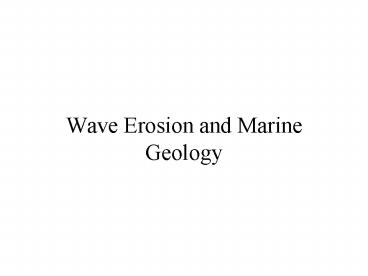Wave Erosion and Marine Geology - PowerPoint PPT Presentation
1 / 33
Title:
Wave Erosion and Marine Geology
Description:
Wave Erosion and Marine Geology – PowerPoint PPT presentation
Number of Views:133
Avg rating:3.0/5.0
Title: Wave Erosion and Marine Geology
1
Wave Erosion and Marine Geology
2
Wave Motions
- Particles in a wave travel circular paths
- The water in a deep-water wave does not move
forward - Below wave base, wave effects are negligible
3
The Highest Recorded Ocean Wave
4
When Waves Meet the Shore
- When the bottom interferes with wave motion, the
wave steepens and the top overtakes the bottom.
5
Wave Refraction
- Waves change path when they reach shallow water
- Wave energy is concentrated on headlands and
spread out in bays
6
Rips
- When waves break parallel to a beach, rips occur
7
Storm Waves Galveston, Texas, September 8, 1900
- 6000-8000 dead
- 3600 houses destroyed
8
Raising Galveston 6 in. to 17 ft.
9
A rickety maze such as Dr. Seuss might have
drawn
10
The Lift in Progress
11
Pumping in the Sand
12
The Galveston Seawall
13
In the long run, nothing is as futile as trying
to resist shoreline change.
- Change can be resisted for a while, but when the
water wants something badly enough, it will come
in and take it.
14
Property Values and Shoreline Erosion
- If more than half the original lot is left, its
Location, Location, Location - After that, it becomes obvious there soon wont
be any location left
15
Freak Waves
- Addition of waves of different frequencies
- Theoretically could reach 200 feet in Gulf of
Alaska - One nearly sank the Queen Mary in WWII, with
15,000 troops aboard.
16
Marine Erosion
- Chemical Attack
- Abrasion
- Wave Impact
- Compressed Air
- Backwash
17
Longshore and Beach Drift
- Most Beach Sand Is Created by Weathering and
Carried to Coasts by Rivers - Beach Sand Moves along the Coast by Longshore and
Beach Drift
18
Types of Coast
- Degree of Modification
- Primary - Not Modified Much by Wave Action
- Secondary - Highly Modified by Wave Action
- History
- Emergent - Land Rises or Water Level Falls
- Submergent - Land Sinks or Water Level Rises
- Dominant Process
- Erosional
- Depositional
19
Effects of the Pleistocene
- Sea level has risen at least 100 meters in the
last 18,000 years - Most coastlines globally are submergent
- Primary coastlines are very common
20
Secondary Coasts Are Modified by Marine Erosion
or Deposition
21
Secondary Coasts
- Erosion
- Stack
- Terraces
- Tombolo
- Erosion rate becomes very slow
- wave energy dissipated crossing the wave-cut
terrace. - Cliffs become higher, meaning more material to
move.
- Deposition
- Spit
- Lagoon
- Baymouth Bar
- Barrier Bar
22
Primary Coastlines Are Very Common
- Drowned River Valleys (Estuaries)
- Drowned Glacial Valleys (Fiords)
23
Other Ways Primary Coasts Can Form
- Deltas
- Volcanic Activity
- Uplift
24
Primary and Secondary Coastlines
25
Delta Coasts
- Deposition-Dominated
- Wave Dominated
- Tide-Dominated
26
The Mississippi A Deposition-Dominated Delta
27
Yukon and Nile Deltas Balance of Deposition and
Wave Action
28
Sao Francisco, Brazil A Wave-Dominated Delta
29
Ganges, Bangladesh A Tide-Dominated Delta
30
Reefs Are a Major Type of Coast in Tropical Areas
31
Tarawa A Typical Atoll
32
Reefs Also Form along the Edges of Large Islands
and Continents
- These Are Barrier Reefs
- Australia
- Yucatan
- Belize
- West Florida
33
Turbidity Flows Grand Banks, 1929

